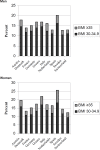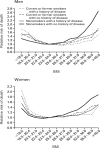Body mass trajectory, energy balance, and weight loss as determinants of health and mortality in older adults
- PMID: 20054222
- PMCID: PMC6516201
- DOI: 10.1159/000221008
Body mass trajectory, energy balance, and weight loss as determinants of health and mortality in older adults
Abstract
The relationship between body mass (usually measured as BMI in kg/m(2)) and healthy longevity is a major focus of study in the nutrition and aging field. Over-nutrition now rivals frailty as the major nutritional concern; the number of older adults who are obese has increased dramatically in the past 3 decades. While obesity exacerbates a host of life-threatening, age-related chronic diseases, a somewhat paradoxical finding is that being somewhat overweight in old age appears to be a benefit with regard to longevity. In our recently completed systematic review of randomized controlled weight reduction trials, we found that weight loss interventions in overweight/obese older subjects led to significant benefits for those with osteoarthritis, coronary heart disease, and type 2 diabetes mellitus, while having slightly negative effects on bone mineral density and lean body mass. In contrast to this finding, the preponderance of epidemiological evidence indicates that higher BMIs are associated with increased survival after age 65 years. Because of this contradictory state of the science, there is a critical need for further study of the relationship of weight and weight loss/gain to health in the later years of life.
Copyright 2009 S. Karger AG, Basel.
Figures



Similar articles
-
Prospective study of intentional weight loss and mortality in overweight white men aged 40-64 years.Am J Epidemiol. 1999 Mar 15;149(6):491-503. doi: 10.1093/oxfordjournals.aje.a009843. Am J Epidemiol. 1999. PMID: 10084238
-
Obesity and weight management in the elderly.Br Med Bull. 2011;97:169-96. doi: 10.1093/bmb/ldr002. Epub 2011 Feb 16. Br Med Bull. 2011. PMID: 21325341 Review.
-
Obesity can benefit survival-a 9-year prospective study in 1614 Chinese nursing home residents.J Am Med Dir Assoc. 2014 May;15(5):342-8. doi: 10.1016/j.jamda.2013.12.081. Epub 2014 Feb 16. J Am Med Dir Assoc. 2014. PMID: 24534518
-
'Obesity paradox' misunderstands the biology of optimal weight throughout the life cycle.Int J Obes (Lond). 2015 Jan;39(1):82-4. doi: 10.1038/ijo.2014.59. Epub 2014 Apr 15. Int J Obes (Lond). 2015. PMID: 24732145
-
Dietary weight-loss interventions for the management of obesity in older adults.Rev Endocr Metab Disord. 2020 Sep;21(3):355-368. doi: 10.1007/s11154-020-09577-2. Rev Endocr Metab Disord. 2020. PMID: 32829454 Review.
Cited by
-
New Therapeutic Approaches and Biomarkers for Increased Healthspan.Adv Exp Med Biol. 2021;1286:1-13. doi: 10.1007/978-3-030-55035-6_1. Adv Exp Med Biol. 2021. PMID: 33725342 Review.
-
Designing health messages for older adults: factors that influence older adults' perceptions of hope for making health behavior changes.J Lang Aging Res. 2024 Nov 11;2(2):6-25. doi: 10.15460/jlar.2024.2.2.1377. Epub 2024 Oct 30. J Lang Aging Res. 2024. PMID: 40406366 Free PMC article.
-
Look into the future through the past.Obes Facts. 2009;2(3):146-9. doi: 10.1159/000224775. Epub 2009 Jun 22. Obes Facts. 2009. PMID: 20054218 Free PMC article. No abstract available.
-
Obese patients in an open MRI at 1.0 Tesla: image quality, diagnostic impact and feasibility.Eur Radiol. 2011 May;21(5):1004-15. doi: 10.1007/s00330-010-2005-2. Epub 2010 Dec 3. Eur Radiol. 2011. PMID: 21127882
-
Low-fat dietary pattern and change in body-composition traits in the Women's Health Initiative Dietary Modification Trial.Am J Clin Nutr. 2011 Mar;93(3):516-24. doi: 10.3945/ajcn.110.006395. Epub 2010 Dec 22. Am J Clin Nutr. 2011. PMID: 21177798 Free PMC article. Clinical Trial.
References
-
- McCay CM, Dilley WE, Crowell MF. Growth rates of brook trout reared upon purified rations, upon dry skim milk diets, and upon feed combinations of cereal grains. J Nutr. 1929;1:233–246.
-
- McCay CM, Maynard LA, Sperling G, Barnes LL. Retarded growth, life span, ultimate body size and age changes in the albino rat after feeding diets restricted in calories: four figures. J Nutr. 1939;18:1–13. - PubMed
-
- Masoro EJ, Yu BP, Bertrand HA, Lynd FT. Nutritional probe of the aging process. Fed Proc. 1980;39:3178–3182. - PubMed
-
- Stuchlíková E, Juricová-Horáková M, Deyl Z. New aspects of the dietary effect of life prolongation in rodents. What is the role of obesity in aging? Exp Gerontol. 1975;10:141–144. - PubMed
MeSH terms
LinkOut - more resources
Full Text Sources
Medical
Miscellaneous

